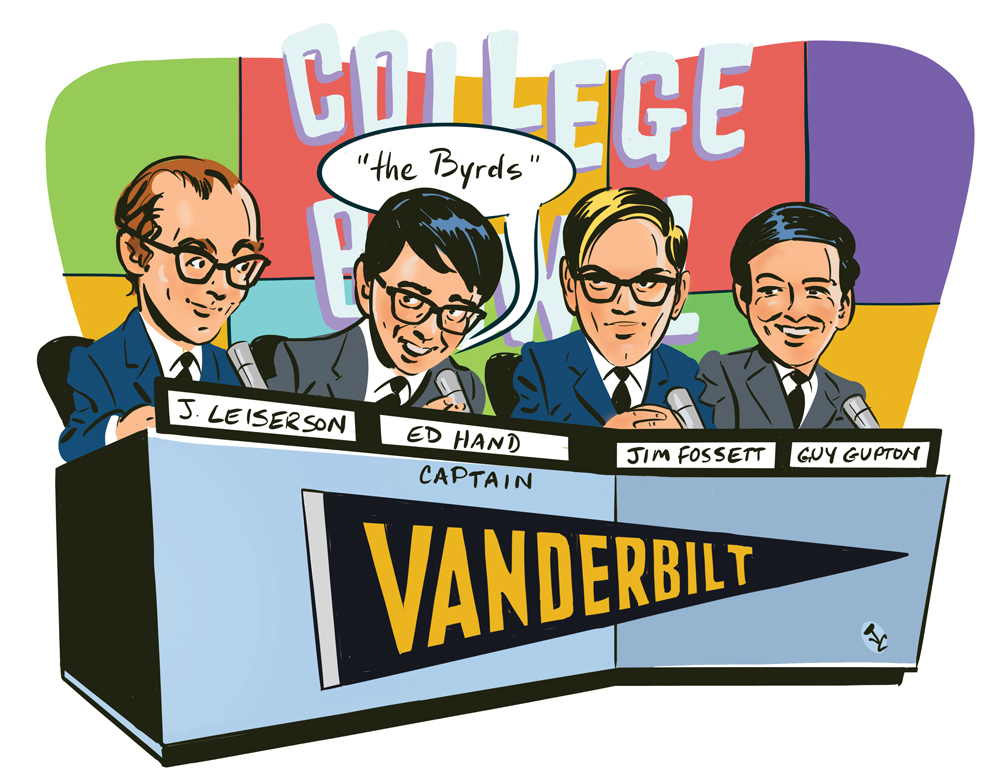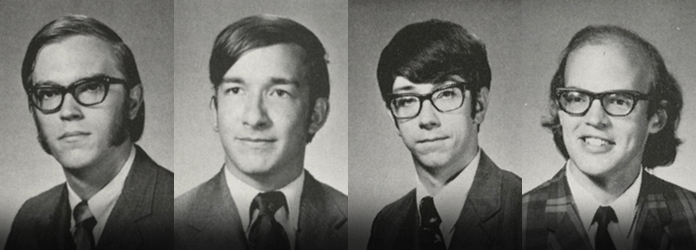By George Spencer

Jim Fossett has a claim to fame that few others besides Beatles legend Paul McCartney can make: He has sung “Hey Jude” to millions of people on television. Sort of. Fossett’s showbiz moment came in 1970 when he warbled the first two lines of the hit song to score points on TV’s College Bowl game show.
Recently revived with NFL Hall of Famer Peyton Manning as host, College Bowl originally aired from 1959 to 1970, pitting teams of college students against each other every Sunday afternoon on NBC. In a bid to win five weeks in a row and thereby be declared a “retired undefeated champion,” teams answered rapid-fire questions on a mix of topics, from cold, hard facts to pop culture trivia.
“I can’t carry a tune in a bucket,” says Fossett, BA’71, a retired professor of public administration at the University of Albany, in recalling his singing debut on national TV. “I was doing the best I could, and the guy who was refereeing just shook his head and laughed. I think he said, ‘Yeah, go ahead and give it to him. He’s close enough.’”
The Vanderbilt team—comprising Fossett, Guy Gupton III, BA’71, captain Ed Hand, BA’71, and John Leiserson, BE’71—racked up victories against the University of Connecticut, Colorado State University and Rutgers University before losing to Claremont McKenna College.
Ten years earlier, another Vanderbilt quartet composed of Bob Andrews ’61, Rollin Lasseter, BA’61, captain Charles Ryan, BA’63, and John Wilson, BA’61, amassed an even more impressive record. They nabbed four victories before being dumped by the “feminine Fulbrights” of Vassar College, as The Tennessean described them.
Gupton, an attorney in Atlanta, can identify with how that earlier group from Vanderbilt must have felt, having advanced so far and then falling just short. The toughest questions were the difference makers, and there is no way to sugarcoat the disappointment more than 50 years later.
“They just got the hard questions right,” he says of his own team’s loss to Claremont McKenna. “That’s all.”
MEMORABLE MATCHES—AND FUN IN MANHATTAN
Tryouts for the 1970 squad began four months earlier, when 75 students stared down a paper test administered by their coach, Randall Fisher, an associate professor of speech. Among its 50 questions was this stumper: “Name the three Republicans who President Roosevelt made fun of in the early 1940s.” The answer? Martin, Barton and Fish.
A committee of professors and students picked the foursome, plus alternate Geoff Waters, BA’70, for their “storehouse of knowledge plus aggressive competitiveness,” according to Fisher. After being winnowed down, they began twice weekly practice sessions using a simulated buzzer to sharpen their reflexes.
Their far-flung intellectual cramming included such practice questions as “What scientist won the Nobel Prize in 1946 for his experiments on the fruit fly?” and “Who created the fictional sleuth Sam Spade?” (Geneticist Hermann J. Muller and author Dashiell Hammett.)
No subject eluded their attention. “We have trouble with nursery rhymes. Dr. Fisher has threatened to send us home to study them,” Leiserson, the son of Vanderbilt political science professor Avery Leiserson, admitted to a local paper.
Each week, NBC flew the team to Manhattan, put them up in the swanky midtown Warwick Hotel, paid for their meals and gave them free tickets to Broadway shows. They saw Hair, The Front Page and Sheep on the Runway, as well as the opera La bohéme at the Met. “Hair was just fantastic,” Fossett says. “At the time it was quite risqué because there’s a scene at the end where everybody’s naked on stage. None of us had ever seen anything like that before.”

STUMPED BY A PAINTING AND A STONE
The team also found themselves on the edge of their seats in their contest against UConn during their first weekend in New York City—but for an entirely different reason. “We pulled it out at the end only because we got a string of questions that we just killed,” Fossett recalls. “From what I heard, every TV set at Vanderbilt was tuned in.”
One brain-buster the team encountered during their impressive string of victories was “At what temperature are Celsius and Fahrenheit the same?” After desperately trying to recall the formula, Fossett scribbled out the correct answer: minus 40 degrees. Later he learned that a bunch of Vanderbilt engineering students sitting around one TV had been screaming out the answer.
The missed answers, however, are what stand out the most in the team members’ memories. More than a half century later, Gupton is still haunted by two questions that stumped him—both of which came in the fourth match against Claremont McKenna.
“They showed us a painting, and the question was ‘Who painted this?’” he recalls. “Nobody knew the answer. I guessed Kandinsky. It was just impossible. The answer was somebody named Franz Klein.”
Yet, Gupton felt even more frustrated when College Bowl host Robert Earle asked, “What philosopher was Samuel Johnson referencing when he kicked the stone?” Neither team knew the answer was Irish thinker George Berkeley, who denied that anything material exists. “I refute him thus,” Johnson had declared as he gave the stone a kick, according to his biographer, James Boswell. It is a piece of literary trivia that Gupton, a former English major, believes he should have known.
Meanwhile, retired Justice Department attorney Hand remembers his botched answer from the final ill-fated game when the competitors were asked to name the songwriter of a particular song. “They started playing ‘Turn! Turn! Turn!’” he says. “A group called the Byrds had recently done that. I hit the buzzer and said, ‘The Byrds!’ But Earle looked at me funny because the correct answer was Pete Seeger.”
During their monthlong jet-setting experience, the Vanderbilt squad achieved only the most modest degree of campus celebrity. No one in Nashville saw their second appearance—the Bing Crosby Pro-Am Golf Tournament preempted the show on WSM. Perhaps mercifully, when the team flew home after their dispiriting loss, students on campus were more preoccupied with the recent successes of the men’s basketball team than anything else.
Gupton remembers being recognized in the cafeteria, and Fossett hoped his TV derring-do might win him female admirers. “There was one not-quite-a-girlfriend, a real good friend of mine, who said her entire pledge class wanted to meet me, but nothing ever came of it,” he says.
“We thought they might win five,” Earle said about the Vanderbilt team after their last match. “But in any game a team can miss a couple of questions and never catch up.”
For its four appearances, the team racked up $10,000 in scholarship money, nearly $75,000 in today’s dollars. The 1960 challengers took home $6,500, or the equivalent of $63,500.
Looking back, the four members of the 1970 squad have fond memories of their weekends in New York City. Mostly fond, that is. The missed answers still needling him all these years later, Gupton on occasion catches himself wondering what might have been.
“I just wish to God the answer had been Kandinsky,” he sighs. “It was such a hard question.”
Freelance writer George Spencer is based in Hillsborough, North Carolina.